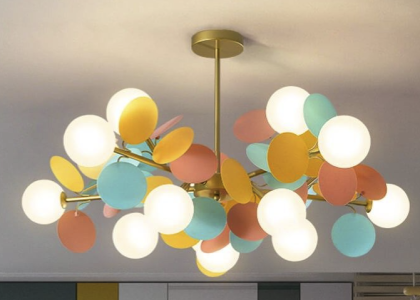Proper lighting Yigo is crucial when it comes to creating a comfortable and inviting living room space. The right lighting can have a significant impact on the overall ambiance of the room, as well as on your mood and productivity. Whether you’re relaxing after a long day, working on a project, or entertaining guests, having the right lighting can make all the difference.
One of the main benefits of proper lighting in your living room is relaxation. Soft, warm lighting can create a calming and soothing atmosphere, helping you unwind and de-stress. On the other hand, bright and vibrant lighting can energize and invigorate you, making it ideal for activities that require focus and concentration.
In addition to relaxation, proper lighting can also enhance your productivity. Bright task lighting can help you stay focused and alert when working or studying in your living room. It can also reduce eye strain and fatigue, allowing you to work for longer periods without feeling tired.
Furthermore, lighting has a significant impact on your mood. Different types of lighting can evoke different emotions and feelings. For example, warm and dim lighting can create a cozy and intimate atmosphere, perfect for spending quality time with loved ones or enjoying a movie night. On the other hand, bright and colorful lighting can create a lively and festive ambiance, ideal for parties or gatherings.
Types of Lighting: Understanding the Different Options Available
To create the perfect lighting scheme in your living room, it’s essential to understand the different types of lighting available. Each type serves a specific purpose and contributes to the overall ambiance of the room.
1. Natural Lighting:
Natural lighting refers to the use of sunlight to illuminate a space. It is considered the most desirable form of lighting due to its numerous benefits. Natural light not only provides excellent illumination but also offers health benefits such as improved mood, increased vitamin D production, and better sleep quality.
To maximize the benefits of natural lighting in your living room, it’s essential to position your furniture and windows strategically. Avoid blocking windows with heavy curtains or furniture that can obstruct the flow of light. Instead, opt for sheer curtains or blinds that allow natural light to filter through while still providing privacy.
2. Ambient Lighting:
Ambient lighting, also known as general lighting, is the primary source of illumination in a room. It sets the overall mood and provides a comfortable level of brightness for everyday activities. Ambient lighting can be achieved through various fixtures such as ceiling lights, chandeliers, or wall sconces.
To create a warm and inviting atmosphere with ambient lighting, consider using dimmer switches. Dimmers allow you to adjust the brightness of the lights according to your needs and preferences. This flexibility can help create different moods and enhance the overall ambiance of your living room.
3. Accent Lighting:
Accent lighting is used to highlight specific decorative pieces or architectural features in a room. It adds depth and visual interest to your living room by drawing attention to focal points such as artwork, sculptures, or bookshelves. Accent lighting can be achieved through spotlights, track lighting, or wall-mounted fixtures.
When using accent lighting in your living room, it’s important to consider the placement and angle of the fixtures. Experiment with different positions to find the best way to showcase your favorite decorative pieces. Additionally, consider using adjustable fixtures that allow you to direct the light precisely where you want it.
4. Task Lighting:
Task lighting is designed to provide focused illumination for specific activities such as reading, working, or relaxing. It helps reduce eye strain and provides adequate light for tasks that require precision and concentration. Task lighting can be achieved through desk lamps, floor lamps, or pendant lights.
When choosing task lighting for your living room, consider the type of activities you will be performing in that space. For example, if you enjoy reading in your living room, a floor lamp with an adjustable arm and a focused beam of light would be ideal. If you often work on your laptop, a desk lamp with a flexible neck and adjustable brightness would be more suitable.
Natural Lighting: Maximizing the Benefits of Sunlight in Your Living Room
Natural lighting is not only aesthetically pleasing but also offers numerous benefits for your living room. Here are some advantages of maximizing natural light in your space:
1. Health Benefits:
Exposure to natural light has been linked to various health benefits. Sunlight helps regulate our circadian rhythm, which is responsible for our sleep-wake cycle. By allowing natural light into your living room, you can improve your sleep quality and overall well-being.
In addition, natural light is a great source of vitamin D, which is essential for bone health and immune function. Spending time in a sunlit living room can help boost your vitamin D levels and improve your overall health.
2. Energy Efficiency:
Maximizing natural light in your living room can also help reduce energy consumption and lower your electricity bills. By relying on sunlight during the day, you can minimize the need for artificial lighting, especially during daylight hours.
To maximize natural light in your living room, consider the following tips:
– Keep windows clean: Dirty windows can block sunlight from entering your living room. Regularly clean your windows to ensure maximum light penetration.
– Use light-colored curtains or blinds: Light-colored window treatments can help reflect sunlight into your living room while still providing privacy.
– Avoid heavy furniture near windows: Heavy furniture can block sunlight from entering your living room. Arrange your furniture away from windows to allow maximum light penetration.
– Use mirrors strategically: Placing mirrors opposite windows can help reflect and amplify natural light in your living room.
Ambient Lighting: Creating a Warm and Inviting Atmosphere
Ambient lighting plays a crucial role in setting the mood and creating a warm and inviting atmosphere in your living room. Here are some tips for achieving the perfect ambient lighting:
1. Layered Lighting:
To create a well-balanced and visually appealing ambiance, consider using layered lighting. Layered lighting involves combining different types of lighting fixtures to achieve the desired effect. For example, you can combine recessed ceiling lights with wall sconces and floor lamps to create a warm and inviting atmosphere.
2. Dimmer Switches:
Installing dimmer switches for your ambient lighting fixtures can provide flexibility and allow you to adjust the brightness according to your needs and preferences. Dimmers are particularly useful for creating different moods in your living room, whether you want a bright and vibrant space or a cozy and intimate atmosphere.
3. Warm Color Temperature:
When selecting bulbs for your ambient lighting fixtures, opt for bulbs with a warm color temperature. Warm white or soft white bulbs (around 2700-3000 Kelvin) create a cozy and inviting ambiance, perfect for living rooms. Avoid using bulbs with cool or daylight color temperatures, as they can create a harsh and sterile atmosphere.
Different types of ambient lighting fixtures can be used to achieve the desired effect in your living room:
– Ceiling lights: Recessed ceiling lights or flush mount fixtures provide general illumination and are ideal for evenly lighting up the entire space.
– Chandeliers: Chandeliers add elegance and sophistication to your living room while providing ambient lighting. They come in various styles and designs to suit different decor themes.
– Wall sconces: Wall sconces are mounted on walls and provide indirect lighting that adds depth and visual interest to your living room. They can be used as accent lighting as well.
– Floor lamps: Floor lamps are versatile fixtures that can be used for both ambient and task lighting. They provide soft, diffused light that creates a cozy atmosphere.
Accent Lighting: Highlighting Your Favorite Decorative Pieces
Accent lighting is essential for showcasing your favorite decorative pieces and adding visual interest to your living room. Here’s why accent lighting is important and how you can use it effectively:
1. Showcasing Decorative Pieces:
Accent lighting draws attention to specific decorative pieces or architectural features in your living room. It adds depth and visual interest, making your space more visually appealing. Whether you have a beautiful artwork, a collection of sculptures, or a bookshelf filled with books, accent lighting can help highlight these pieces and make them stand out.
2. Creating Drama and Contrast:
Accent lighting can create drama and contrast in your living room by playing with light and shadow. By strategically placing accent lighting fixtures, you can create interesting patterns and highlight specific areas or objects. This adds depth and dimension to your space, making it more visually appealing.
Different types of accent lighting fixtures can be used to achieve the desired effect in your living room:
– Spotlights: Spotlights are adjustable fixtures that can be used to direct light precisely where you want it. They are ideal for highlighting specific decorative pieces or architectural features.
– Track lighting: Track lighting consists of multiple adjustable fixtures mounted on a track. It allows you to position the lights according to your needs and preferences, making it ideal for accent lighting.
– Wall-mounted fixtures: Wall-mounted fixtures such as picture lights or wall sconces can be used to highlight artwork or other decorative pieces on the wall.
– Under-cabinet lighting: If you have display cabinets or shelves in your living room, under-cabinet lighting can be used to highlight the items on display.
Task Lighting: Illuminating Specific Areas for Reading, Working, or Relaxing

Task lighting is essential for providing focused illumination for specific activities such as reading, working, or relaxing in your living room. Here’s why task lighting is beneficial and how you can use it effectively:
1. Benefits of Task Lighting:
Task lighting provides concentrated light for activities that require precision and concentration. It helps reduce eye strain and fatigue, allowing you to work or read for longer periods without feeling tired. Task lighting also creates a sense of coziness and intimacy when used for relaxation activities such as reading or knitting.
2. Different Types of Task Lighting Fixtures:
There are various types of task lighting fixtures that can be used in your living room:
– Desk lamps: Desk lamps are ideal for providing focused illumination for tasks such as reading, writing, or working on a laptop. They come in various styles and designs to suit different decor themes.
– Floor lamps: Floor lamps with adjustable arms or heads can be used as task lighting fixtures. They provide flexibility and allow you to direct the light precisely where you need it.
– Pendant lights: Pendant lights can be used as task lighting fixtures when placed above specific areas such as a reading nook or a work desk.
– Table lamps: Table lamps are versatile fixtures that can be used for both ambient and task lighting. They provide focused illumination for specific areas or activities.
When choosing task lighting fixtures for your living room, consider the type of activities you will be performing in that space. For example, if you enjoy reading in your living room, a floor lamp with an adjustable arm and a focused beam of light would be ideal. If you often work on your laptop, a desk lamp with a flexible neck and adjustable brightness would be more suitable.
Choosing the Right Bulbs: Understanding Color Temperature and Brightness
Choosing the right bulbs for your living room is crucial to create the desired ambiance and achieve optimal lighting conditions. Here’s what you need to know about color temperature and brightness:
1. Color Temperature:
Color temperature refers to the appearance of light emitted by a bulb, ranging from warm to cool tones. It is measured in Kelvin (K). The color temperature of a bulb can significantly impact the ambiance of your living room.
– Warm white (2700-3000K): Warm white bulbs emit a soft, yellowish light that creates a cozy and inviting atmosphere. They are ideal for living rooms and areas where you want to create a warm and intimate ambiance.
– Cool white (3500-4100K): Cool white bulbs emit a bright, white light that creates a clean and crisp atmosphere. They are ideal for areas where you need task lighting or want to create a bright and vibrant ambiance.
– Daylight (5000-6500K): Daylight bulbs emit a bright, bluish light that simulates natural daylight. They are ideal for areas where you need to replicate natural lighting conditions or want to create a cool and energizing atmosphere.
When selecting bulbs for your living room, consider the mood and ambiance you want to create. Warm white bulbs are generally the most popular choice for living rooms as they create a cozy and inviting atmosphere.
2. Brightness:
Brightness refers to the amount of light emitted by a bulb and is measured in lumens (lm). The brightness of a bulb can significantly impact the functionality and comfort of your living room.
– General lighting: For ambient lighting fixtures, such as ceiling lights or chandeliers, choose bulbs with higher lumen output to ensure adequate illumination for the entire space.
– Task lighting: For task lighting fixtures, such as desk lamps or floor lamps, choose bulbs with lower lumen output to provide focused illumination without causing glare or discomfort.
When selecting bulbs for your living room, consider the purpose of each lighting fixture and choose bulbs with appropriate brightness levels accordingly.
Lighting Fixtures: Selecting the Best Options for Your Living Room Space
Selecting the right lighting fixtures is crucial to achieve the desired ambiance and functionality in your living room. Here are some factors to consider when choosing lighting fixtures:
1. Style and Design:
Consider the overall style and design of your living room when selecting lighting fixtures. Choose fixtures that complement the existing decor and enhance the aesthetic appeal of the space. Whether your living room has a modern, traditional, or eclectic style, there are lighting fixtures available to suit every taste and preference.
2. Size and Scale:
Consider the size and scale of your living room when selecting lighting fixtures. Choose fixtures that are proportionate to the size of the space and the height of the ceilings. Oversized fixtures can overwhelm a small living room, while undersized fixtures can get lost in a large living room.
3. Functionality:
Consider the functionality of each lighting fixture and how it will be used in your living room. Determine whether you need ambient lighting, accent lighting, or task lighting in specific areas. Choose fixtures that provide the desired level of illumination and functionality for each purpose.
Different types of lighting fixtures can be used in your living room to achieve the desired effect:
– Ceiling lights: Ceiling lights, such as recessed lights or flush mount fixtures, provide general illumination for the entire space.
– Chandeliers: Chandeliers add elegance and sophistication to your living room while providing ambient lighting.
– Pendant lights: Pendant lights can be used as focal points or task lighting fixtures when placed above specific areas.
– Wall sconces: Wall sconces provide indirect lighting that adds depth and visual interest to your living room.
– Floor lamps: Floor lamps are versatile fixtures that can be used for both ambient and task lighting.
– Table lamps: Table lamps are smaller fixtures that are typically used for task lighting or as decorative accents. They are often placed on bedside tables, desks, or side tables to provide focused lighting for reading, working, or creating a cozy atmosphere. Table lamps come in a variety of styles and sizes, making them a popular choice for adding both functionality and style to any space.









